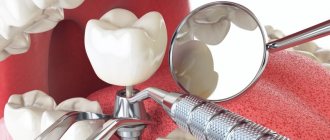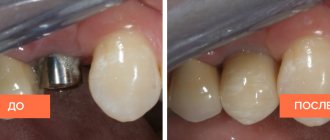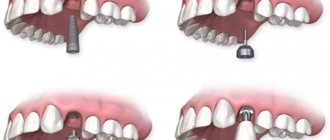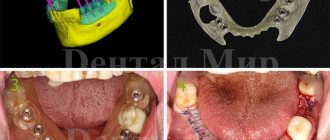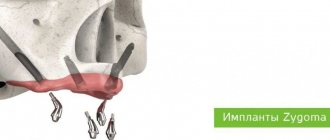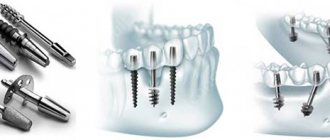More and more patients are turning to the dentist to restore all their teeth, or one jaw completely. Conventional removable dentures, partial dentures and extended metal-ceramic bridges do not meet the high requirements for comfort, aesthetics and durability. All of these goals can be achieved with dental implants.
The technique of jaw implantation in the absence of teeth is significantly different from implantation in the absence of only a few teeth. For example, it is an obvious fact that you do not need to install 32 implants to restore all your teeth. All the details of full dental implantation are outlined in this article.
Methods of prosthetics on implants in the absence of teeth
Prosthetics on implants in the absence of teeth can be divided into 3 types: removable, fixed and conditionally removable.
Removable prosthetics on implants is suitable for those patients who have already used a removable denture, but could not get used to it. Any option of removable prosthetics on implants will greatly improve the quality of life of such patients.
However, if you have never used a removable denture, then psychologically it will not be easy to get used to such a design. In this case, the best option would be fixed or conditionally removable prosthetics on implants. Conditionally removable means that the prosthesis is fixed with screws. It can only be removed by a dentist; the patient uses it as if he were his own teeth.
Implantation of both jaws with simultaneous loading with plastic crowns
More details about each treatment method are described later in this article.
Features of implantation of anterior teeth
The success of implantation of anterior teeth consists of: the knowledge and skills of the doctor, choosing the optimal solution together with the patient, a high-quality implant, professional prosthetics of the implant, the condition and amount of bone, the general health of the patient, as well as postoperative procedures - compliance with recommendations during the healing period and impeccable hygiene during throughout the entire period of use. However, despite the fact that many factors influence the final result, the effectiveness of such treatment is very high.
To get a consultation
Lower jaw implantation
The lower jaw is denser in structure than the upper jaw, so in most cases, 2 to 6 implants are enough to restore all teeth. The integration period for implants in the lower jaw is 3 months.
Removable prosthetics on implants in the lower jaw are carried out on 2-4 implants. The most common option is to install 4 implants with spherical attachments (or locators). The advantages of this method are good fixation of the prosthesis, easy oral hygiene, simplicity of design, and, as a result, its low cost. A removable prosthesis on 2 implants with attachments is used in cases where there is not enough bone tissue to install 4; the fixation of the prosthesis in this case is worse. The disadvantages of this treatment method are that the prosthesis distributes the load not only on the implants, but also on the gums. Under the pressure of the prosthesis, the gums atrophy, so it is necessary to reline the prosthesis on average once a year. The fastening on the attachments also weakens; it is necessary to periodically replace the retention matrices. The service life of the prosthesis itself is about 5 years.
Removable denture on 4 implants with spherical attachments on the lower jaw
The second option for a removable prosthesis on the lower jaw is prosthetics of the lower jaw on a beam on 4 implants. In this case, the load is distributed mainly on the implants and much less on the gums. The fixation of the prosthesis is very tight, the prosthesis feels almost like your own teeth. The prosthesis itself is made of plastic. It completely restores aesthetics and chewing function. The fact that the denture is removable simplifies oral hygiene. A plastic prosthesis is not as rigid as a metal-ceramic or zirconium one, so it is easier for people who have problems with the temporomandibular joint to get used to it. The disadvantage of this treatment method is that a properly manufactured beam prosthesis is comparable in cost to a fixed structure.
One of the main conditions for the long-term functioning of such a prosthesis is that the beam connecting the implants must be very accurately connected to them. For this, multi-unit abutments are used, which ensure precise connection of the implant with the beam; the beam itself must be made on a milling machine. Unfortunately, patients are often offered a bar prosthesis made without multi-unit abutments, or made by casting rather than milling. In this case, the beam will be fixed to the implants with tension, which will lead to a negative result, possibly even to the loss of the implants due to their overload.
Removable denture on a beam fixation on the lower jaw
Fixed prosthetics of the lower jaw are performed on 6 implants with classical implantation. It is also possible to restore teeth on 4 implants using the all-on-4 method, in which case 2 of the 4 implants are placed at an angle of up to 45 degrees. The technique has its pros and cons. All-on-4 will be written about later in this article.
Fixed prosthetics completely imitate your own teeth and are the easiest to tolerate psychologically. During the period of implant integration, the patient uses a temporary removable prosthesis, or dental implantation is carried out with a simultaneous load using a fixed plastic prosthesis. The service life of a plastic prosthesis is 1 year. It can be replaced with metal-ceramic or zirconium after the implants have completely healed. On the lower jaw after 3 months. The implants themselves are not affected.
In the case when a permanent prosthesis is made with screw fixation, we are talking about conditionally removable prosthetics on implants. Conditionally removable means that the prosthesis can only be removed by a dentist. The patient cannot remove it on his own; it feels and functions like his own teeth.
The advantages of screw fixation are that the prosthesis can be removed if necessary. Unlike cemented dentures, which cannot be removed without sawing them. However, the complexity of the design, and as a consequence the cost, is increasing.
Fixed denture on the upper jaw on 6 implants, on the lower jaw on 6 implants
How long can it take to implant 5 teeth?
Before implantation, you need to go through a preparatory stage, which includes sanitation of the oral cavity and medical procedures. If you have serious dental diseases, therapeutic procedures will take a long time. Titanium rods are placed only in conditions of absolute health of all dental units.
The operation to implant one implant lasts about half an hour . The final stage is the installation of a permanent prosthesis. In general, implantation using the classical method takes about 4-6 months . If one-stage or one-stage is used , it will take only 4-6 days .
Upper jaw implantation
The bone tissue of the upper jaw is less dense than that of the lower jaw, therefore, for complete prosthetics on implants in the upper jaw, more implants are needed - from 4 to 8. Healing of implants in the upper jaw occurs within 6 months.
Removable prosthetics of the upper jaw are performed on 4-6 implants. On 4 implants it is possible to install an overdenture with spherical attachments. The overdenture has the same boundaries as a regular removable one; it completely covers the palate. To make a prosthesis on the upper jaw without a palate, you need to install 6 implants. Ball-shaped attachments, locators or a beam can be used as connecting elements. The best fixation of the prosthesis is achieved on a beam. However, the cost of such a prosthesis is comparable to a fixed structure.
For fixed prosthetics of the upper jaw, it is necessary to install from 6 to 8 implants. It is also possible to install a fixed denture on the upper jaw on 4 implants using the all-on-4 technique. It will be written about later in this article.
Installing 6-8 implants in the classical way is the most studied and reliable option for implanting the upper jaw. The number of implants is determined by the presence of bone tissue and the shape of the upper jaw. While the implants are healing, the patient uses a temporary removable prosthesis, or implantation is carried out with a simultaneous load using a fixed plastic prosthesis.
The service life of a plastic prosthesis is 1 year. It can be replaced with metal-ceramic or zirconium after the implants have completely healed. On the upper jaw after 6 months. The implants themselves are not affected.
Just like in the lower jaw, in the upper jaw it is possible to make a permanent screw-retained structure - conditionally removable prosthetics. Only a dentist can remove a screw-retained prosthesis. The patient uses it as if he were his own teeth.
The advantages of screw fixation are that the prosthesis can be removed if necessary. Unlike cemented dentures, which cannot be removed without sawing them. However, the complexity of the design, and as a consequence the cost, is increasing.
Different implantation options for complete absence of teeth. 8 implants on the lower jaw, 6 implants on each jaw, 8 implants on the upper jaw
Front upper teeth
The main task of installing anterior dental implants is the optimal combination of functionality and aesthetics. Therefore, the operation has the following features:
- aesthetic gum contour - creating a beautiful gum contour will not give others a chance to guess about the presence of an implant. To ensure that the gums do not lose volume, they often resort to one-stage implantation with immediate loading using a temporary crown. The latter provides some support to the gingival tissues and prevents changes in their structure;
- accuracy of installation - a computed tomography scan is required, since the implantation of an artificial root in place of the front teeth of the upper jaw must be carried out at a precise angle. Otherwise, there is a possibility of difficulties with crown installation;
- A special feature of the design of artificial roots is that the implants have a relatively small diameter and specific thread. Such designs are used to reduce trauma to surrounding tissues;
- aesthetics - unlike many other cases, instead of a metal abutment (the part on which the crown is fixed), a zirconium abutment is used. This is because the metal may be visible. Zirconium is white, which eliminates the risk of this part being visible through the gum. Crown materials - zirconium dioxide, solid ceramics - have high aesthetic characteristics and can be safely used to restore front teeth.
All-on-4
The All-on-4 technique (all-on-four) was developed by Nobel Biocare. It involves the installation of 4 implants on one jaw with simultaneous loading with a fixed prosthesis on a screw fixation. The 2 outermost implants are placed at an angle of up to 45 degrees, which allows you to bypass anatomically difficult places: the maxillary sinuses in the upper jaw and the nerve exit site in the lower jaw.
Initially, the All-on-4 technique was positioned as minimally invasive, without bone grafting. However, for successful functioning it is necessary to install sufficiently long implants, because 4 implants must bear the load of the entire dentition. Unfortunately, not all patients have the required alveolar ridge height. Installing shorter implants may result in one of the implants not taking root due to increased load. And then everything-on-four will turn into nothing-on-three. This is why patients are offered “all-on-4 modifications”, for example All-on-6 (all-on-six implants), because Installing an additional 2 implants significantly reduces the risks.
3-6 months after implantation using the All-on-4 method, gaps appear between the prosthesis and the gum, because This is why gum remodeling occurs after implantation. It is necessary to either reline the existing prosthesis or replace it with a permanent one - metal-ceramic or zirconium.
Recommendations
Recommendations after dental implantation of the upper jaw are as follows:
- try to avoid increased stress at first - do not blow your nose (both after bone grafting and for the first time after fixing the implant), do not chew hard foods, postpone flights;
- it is necessary to pay attention to hygiene - brush your teeth and use recommended rinses, visit a doctor according to the schedule;
- limit physical activity;
- avoid visiting the bathhouse, beach, pool;
- take medications prescribed by your doctor.
Following the doctor’s recommendations will reduce the risk of complications and ensure a long service life of the implants.
Bone grafting for jaw implantation
The more implants are installed, the greater the likelihood that the existing bone tissue will not be enough to install implants and it will be necessary to build it up. Bone deficiency can be in thickness (very thin bone) or in height (close to the maxillary sinuses in the upper jaw, nerve in the lower jaw).
If there is a slight lack of bone tissue in thickness, one-step bone grafting with the installation of implants is possible. It is also possible to carry out a sinus lift (a type of bone tissue augmentation when the distance to the maxillary sinus is insufficient) with the one-step installation of implants.
If there is a large deficiency of bone tissue, operations are first performed to build it up (open sinus lift, harvesting and replanting of a bone block), and after 3-6 months, implantation is performed. In this case, the total duration of treatment can be from one to one and a half years.
What's included in the price
Our Center has developed a case-based “turnkey” payment system. Implantation of upper teeth combines cases for installing an implant, crown or prosthesis. If necessary, cases of tooth extraction, bone and soft tissue plastic surgery are added.
The implantation case includes:
- local anesthesia
- implant and its installation
- auxiliary operations for basic bone tissue augmentation, including regeneration stimulators
- applying and removing sutures
- postoperative examinations and CT scans during the rehabilitation period
- antibiotics, painkillers (delivered at home)
The crown installation case includes:
- crown and its installation
- taking impressions
- abutment
How to avoid bone grafting?
There are proven methods that allow you to reliably restore teeth on one or both jaws without additional operations to build bone tissue.
First of all, it’s worth talking about the positions in which implants are installed. Humans have a total of 32 teeth, 16 teeth on each jaw. The 2 outer teeth are wisdom teeth; they do not bear a functional load, therefore they are not restored during prosthetics. Of the remaining 14 teeth (7 on each side), the most problematic in terms of restoration are the sixth and seventh teeth (counting from the center). They are located close to the maxillary sinus in the upper jaw and to the nerve in the lower jaw. It is precisely to restore the sixth and seventh teeth that lengthy osteoplastic operations are necessary.
According to the recommendations of the international association of implantologists ITI - International Team for Implantology , in the case of complete absence of teeth, it is necessary to restore the dentition up to the sixth tooth inclusive (12 teeth on each jaw). This method completely restores both the function of the jaw and the aesthetics of the smile. At the same time, additional risks associated with the close location of anatomically important formations (maxillary sinuses and nerve) are avoided.
In this case, the implants are installed in the anterior part of the jaw, and the outer ones in the area of the fifth teeth (the so-called Frankfurt University protocol ). Subsequently, a one-piece fixed prosthesis is installed on them. Combining all implants into a single structure compensates for lateral chewing loads and ensures full functioning of the entire jaw with only 6 implants in the lower jaw and 6-8 in the upper jaw.
Another problem is a deficiency of bone tissue thickness ( thin bone ). To avoid bone grafting in this case, it is possible to use thin implants. However, not all systems guarantee that their thin implants can withstand the load of full jaw prosthetics. Such guarantees are provided by German implants Ankylos , and the Straumann has developed a special alloy of titanium and zirconium, which allows thin implants to function without building up bone tissue, it is called Straumann Roxolid .
And lastly, if there is a deficiency of bone tissue both in height and width, a possible solution is to install short and thin implants, but in larger quantities. Instead of 6 standard ones - 8 short ones. The total length of the implants in this case will be equal.
Subtleties of implantation of anterior teeth
Anterior tooth implantation has a number of features, since we are talking about the smile zone, an area of increased aesthetic requirements:
- Artificial teeth must be absolutely identical to natural ones (if you are planning an orthopedic system of a lighter shade, you will need to first whiten your teeth).
- The ratio of dental crowns to gums (especially for the upper teeth) is especially carefully taken into account.
- When installing implants, the doctor pays close attention to analyzing the relief of the jaw bone and the thickness of the gums.
- The characteristics of the bite in the frontal zone must be taken into account (some occlusion disorders are an obstacle to implantation.
The main nuances of implanting anterior teeth are related to the fact that the most aesthetic result is expected from a dental prosthetic structure installed in this area, compared to implantation of the chewing group of teeth.
Operation
Medium difficulty
There are contraindications
Doctor's qualifications
High
Which implants to choose?
Today there are more than 3,000 implant systems in the world. However, not all of them can boast a long history of observations and clinical trials around the world. There are also some implant systems that, despite their reliability, are not very common in Russia. This may lead to difficulties in terms of delivery of original components of implant systems.
It is worth choosing only generally recognized implant systems, which are used by different doctors independent of each other. Otherwise, the patient risks finding himself in a situation where no one can help him.
An important point when choosing an implant system is the type of implant-abutment connection. It determines how long the implant will last. The most reliable today is the conical implant-abutment connection with the effect of switching platforms. It is able to withstand greater loads compared to a flat connection, is leak-tight and does not cause resorption of bone tissue around the implant.
The healing of implants is affected by the purity of the titanium from which they are made. The most common is Grade 4 - commercially pure titanium. Grade 1,2,3 alloys are even purer. Grade 5 – less pure, contains impurities of vanadium and aluminum.
The surface of each implant is a unique patented technology, because... It is on the surface of the implant that osseointegration occurs—the fusion of the implant with the bone tissue. Serious implant manufacturing companies conduct a lot of research, proving that their implants are integrated not only in standard situations, but also, for example, in people suffering from diabetes or bleeding disorders. The following systems meet all these requirements: Straumann (Switzerland), Ankylos (Germany), Astra tech (Sweden), Nobel biocare (USA/Sweden). Among the inexpensive systems, we can highlight Osstem implants (South Korea). They have proven themselves throughout the world as a reliable and economical implant system.
Indications and contraindications for installing implants in the upper jaw
Main indications:
- partial or complete edentia;
- aesthetic defects resulting from the destruction of crowns.
Contraindications are conditional (include health problems for which the procedure is prohibited, implantation is possible after their exclusion) and absolute (implantation is contraindicated).
Absolute contraindications:
- chronic teeth grinding;
- increased tone of the masticatory muscles;
- blood clotting disorder;
- diseases of the central nervous system;
- pathologies of the heart and blood vessels;
- dysfunction of the endocrine system.
Relative contraindications:
- inflammatory processes of the oral cavity;
- thinning of the bone structures of the jaw;
- pregnancy and breastfeeding period.
How much does implantation cost if there are no teeth?
Despite the apparent high cost of implantation in the absence of teeth, it may turn out to be more profitable than restoring already hopeless teeth. In addition, the service life of implants is unlimited. Treatment is carried out in stages and is also paid for.
So, the price of jaw implantation in the absence of teeth depends on the type of structure (removable, fixed) and the implant system. For example, the cost of jaw implantation using the classical method with a one-time load with a non-removable plastic prosthesis ranges from 350,000 rubles. The price of a zirconium prosthesis on implants for one jaw starts from 200,000 rubles.
You can get acquainted with the prices for implantation in the absence of teeth by clicking on this link.
Author of the article: Akhtanin Alexander Alexandrovich. Dentist-implantologist, orthopedist. He trained for a long time in Berlin, Germany. Member of the international association of implantologists ITI - International Team for Implantology.
Pros and cons of anterior dental implants
| Advantages | Flaws |
| No grinding or depulpation of adjacent healthy teeth is required | There are contraindications |
| Possibility to place an implant immediately after surgical extraction or tooth loss | It is not always possible to do without osteoplastic surgery |
| Rapid engraftment of artificial root | If the implant fails, the likelihood of success of a repeat operation is greatly reduced. |
| Impeccable aesthetics and full functionality of the dentition | Higher risk of complications than with dental implants |
| Unlimited implant lifespan | It takes time for the implant to take root. |
| Prevention of further loss of the jawbone and gradual restoration of its volume | Rehabilitation period |
| The ability to quickly compensate for both single and multiple dental defects in the frontal zone |
Alternatives to implantation for bone loss
Implantation is the only method of restoring lost teeth that stops bone resorption. But there are cases when surgery is contraindicated or a person is not financially ready to undergo surgery. As an alternative we can offer:
- A dental bridge consists of several crowns welded together, the outer ones of which are attached to the previously ground teeth adjacent to the defect. Metal-ceramic bridges last about 10 years, ceramic and zirconium bridges - from 15 to 25 years. But this method has disadvantages, because... grinding of adjacent healthy teeth is required. In addition, due to uneven pressure, the bone in the area of the defect is resorbed.
- Removable dentures Consist of a plastic base that serves as the gum and artificial teeth attached to it. They are made from various variations of acrylic and softer materials. Service life - 5-10 years. Due to improper load distribution, they put increased pressure on the gums, sag, and require constant relining. The jawbone under such prostheses is actively decreasing.
We recommend not to delay the restoration of the dentition and consider implantation as an effective way to stop the process of bone tissue atrophy. Complete resorption over time makes any type of prosthetics almost impossible .
Stages of implant installation for bone deficiency
- Preparatory The most important stage, to which we pay maximum attention in order to identify and prevent possible risks. We examine the oral cavity and, if diseases of the teeth or gums are detected, we carry out treatment. We examine the maxillofacial apparatus, determine the size of the bone, on the basis of which we make a decision on the method of osteoplasty. Also at the preparation stage, the patient’s health condition is assessed to identify possible contraindications. Based on the data obtained, we plan the stages of treatment, carry out computer modeling of the upcoming operation, select models, and calculate the location of the implants in the jaw.
- Bone grafting When the remaining bone volume is less than 5 mm, it is performed in a separate stage. Rehabilitation after the procedure takes 4-5 months. During this time, the bone graft completely takes root. If the bone size allows (more than 5 mm), bone augmentation is carried out simultaneously with implantation, which significantly reduces treatment time.
- Implantation The implant is fixed in the formed opening of the jaw bone. If one-stage plastic surgery is indicated, manipulations are first performed to increase the size of the bone. The implant is closed with a cover screw and sutures are applied. Osseointegration with jaw tissue takes 4-5 months. During this time, a temporary removable denture is made to hide the aesthetic defect.
- Prosthetics It is strictly forbidden to install a crown or prosthesis on an implant immediately after the procedure, because it is important to ensure reliable fusion of the mobile graft and artificial root with the jaw bone and to avoid displacement. After healing, a gum former is fixed to the implant to create a beautiful gum contour. After 2 weeks, the former is replaced by an abutment, and impressions are taken. The final stage is fixation of the crown or bridge.
The guarantee for dental implantation in our Center is unlimited
We use exclusively premium Nobel Biocare implants, certified bone materials, strictly follow implantation protocols taking into account the size of the bone tissue, and work using low-traumatic technologies. All this ensures rapid engraftment and reliable results for life.
Levin Dmitry Valerievich Chief physician and founder of the Doctor Levin center
Selecting an implant model
When selecting rods for a specific clinical case, the implant surgeon is guided by the following criteria:
- Size - length depends on the height of the alveolar ridge (6-16 mm).
- The material - most models are made of titanium and its alloys - are characterized by high biocompatibility. The presence of impurities in the composition reduces the rate of engraftment and shortens the service life. More expensive models are made from zirconium dioxide.
- Shape - can be cone-shaped, root-shaped, lamellar. The choice of the right one depends on the density of the bone structures.
- Surface - to accelerate osseointegration, manufacturers apply a special composition to the rods that forms a microporous surface. Such processing affects the cost, increasing it.
- Availability of threads - one implant can have 2-3 threads to accommodate different degrees of bone density in different areas.
- Type of connection between the abutment and the crown . This is the most fragile place of the structure - it is here that it is susceptible to fracture and loosening. To prevent such consequences, a triangular type of connection was invented.
In addition to the above points, it is worth considering:
- compatibility with osteoplasty methods;
- installation complexity;
- survival rate;
- durability;
- aesthetics.
Implantation systems of excellent quality are produced by the following companies:
- Nobel Biocare;
- Straumann (Switzerland);
- XIVe (Germany);
- Anthogyr (France);
- Astra Tech (Sweden).
They cost between 35,000 and 70,000 rubles. Products from manufacturers from Russia, Belarus, Ukraine, Israel, and Korea are more accessible. Their prices range from 7,000 to 25,000 rubles.
Complications
Those who are planning implantation in the absence of teeth in the upper jaw should be aware that the following complications during implantation are possible:
- swelling after tooth implantation in the upper jaw;
- numbness of the upper lip;
- nosebleeds;
- rejection of bone material;
- increased mobility of the implant;
- rejection.
The above problems may arise due to poor oral care, the general somatic health of the patient, or due to improper planning of surgical treatment. Therefore, in order to prevent complications after implantation of upper teeth, it is necessary to provide the installed implants with proper postoperative care and choose a clinic with a good reputation, experienced specialists and modern equipment.
At what stages of implantation is bone tissue augmentation performed?
Jawbone atrophy occurs with varying intensity and is classified into 3 stages, according to which our implantologists decide on the need for bone grafting, the methods and order of its implementation:
- Initial Accompanied by slight bone resorption, which does not affect the blood supply and severity of the alveolar process. At this stage, a basic extension along the neck of the implant with a growth stimulator is sufficient. In this way, natural regeneration processes are activated, which contributes to the independent restoration of bone tissue.
- Moderate Characterized by increased atrophic process of bone tissue, slight smoothing of the alveolar ridge, and gum recession. It is no longer possible to do without bone grafting. However, it can still be carried out simultaneously with the installation of implants .
- Critical There is pronounced atrophy, smoothing of the contours of the jaw bone from the inside and outside. The bite is disrupted, the teeth adjacent to the defect move in the direction of the missing ones, and the proportions of the face change. Before implantation, a separate stage is used to build up the missing bone volume.
How much does it cost to get teeth on implants?
Scientific Dentistry Dentistoff provides packages of services for jaw restoration on implants, which include the cost of all manipulations from consultation with an implantologist to fixation and maintenance of dentures. The price includes:
- consultation and preliminary examination;
- local anesthesia;
- implants;
- multi-unit abutments;
- computed radiography after surgery;
- production and fixation of the prosthesis;
- post-operative support;
- doctors' work.
The price depends on the number and brand of implants. Additionally, costs may be required for bone grafting (if indicated). We also provide jaw reconstruction services while you sleep; anesthesia or sedation is paid separately.

